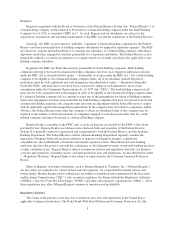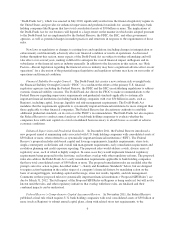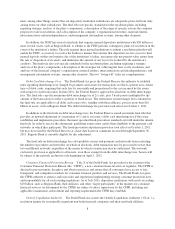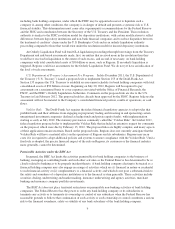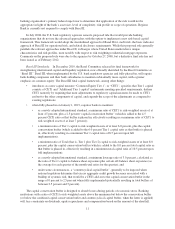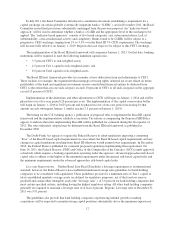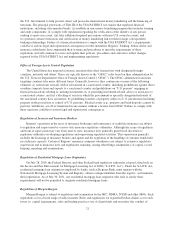Regions Bank 2011 Annual Report Download - page 37
Download and view the complete annual report
Please find page 37 of the 2011 Regions Bank annual report below. You can navigate through the pages in the report by either clicking on the pages listed below, or by using the keyword search tool below to find specific information within the annual report.levels without significant reliance on intangible assets. Furthermore, the Federal Reserve has indicated that it will
consider a “tangible Tier 1 capital leverage ratio” (deducting all intangibles) and other indicators of capital
strength in evaluating proposals for expansion or new activities.
Liquidity Requirements. Historically, regulation and monitoring of bank and bank holding company
liquidity has been addressed as a supervisory matter, both in the U.S. and internationally, without required
formulaic measures. The Basel III final framework requires banks and bank holding companies to measure their
liquidity against specific liquidity tests that, although similar in some respects to liquidity measures historically
applied by banks and regulators for management and supervisory purposes, going forward will be required by
regulation. One test, referred to as the liquidity coverage ratio (“LCR”), is designed to ensure that the banking
entity maintains an adequate level of unencumbered high-quality liquid assets equal to the entity’s expected net
cash outflow for a 30-day time horizon (or, if greater, 25 percent of its expected total cash outflow) under an
acute liquidity stress scenario. The other, referred to as the net stable funding ratio (“NSFR”), is designed to
promote more medium- and long-term funding of the assets and activities of banking entities over a one-year
time horizon. These requirements will incentivize banking entities to increase their holdings of U.S. Treasury
securities and other sovereign debt as a component of assets and increase the use of long-term debt as a funding
source. The Basel III liquidity framework contemplates that the LCR will be subject to an observation period
continuing through mid-2013 and subject to any revisions resulting from the analyses conducted and data
collected during the observation period, implemented as a minimum standard on January 1, 2015. Similarly, it
contemplates that the NSFR will be subject to an observation period through mid-2016 and, subject to any
revisions resulting from the analyses conducted and data collected during the observation period, implemented as
a minimum standard by January 1, 2018.
As discussed above under “—Regulatory Reforms,” the Proposed SIFI Rules address liquidity requirements
for bank holding companies. including Regions, with $50 billion or more in total consolidated assets. In the
release accompanying those rules, the Federal Reserve states a general intention to incorporate the Basel III
liquidity framework for the bank holding companies covered by the Proposed SIFI Rules or a “subset” of those
bank holding companies. Although these rules do not include prescriptive ratios like the LCR and NSFR, they do
include detailed liquidity-related requirements, including requirements for cashflow projections, liquidity stress
testing (including, at a minimum, over time horizons that include an overnight time horizon, a 30-day time
horizon, a 90-day time horizon and a 1-year time horizon), and a requirement that covered bank holding
companies maintain a liquidity buffer of unencumbered highly liquid assets sufficient to meet projected net cash
outflows and the projected loss or impairment of existing funding sources for 30 days over a range of liquidity
stress scenarios.
Capital Requirements of Regions Bank. Regions Bank is subject to substantially similar capital
requirements as those applicable to Regions. As of December 31, 2011, Regions Bank was in compliance with
applicable minimum capital requirements. Neither Regions nor Regions Bank has been advised by any federal
banking agency of any specific minimum capital ratio requirement applicable to it as of December 31, 2011.
Failure to meet capital guidelines could subject a bank to a variety of enforcement remedies, including the
termination of deposit insurance by the FDIC, and to certain restrictions on its business. See “—Regulatory
Remedies under the FDIA” below.
Safety and Soundness Standards
Guidelines adopted by the federal bank regulatory agencies pursuant to the Federal Deposit Insurance Act,
as amended (the “FDIA”), establish general standards relating to internal controls and information systems,
internal audit systems, loan documentation, credit underwriting, interest rate exposure, asset growth and
compensation, fees and benefits. In general, these guidelines require, among other things, appropriate systems
and practices to identify and manage the risk and exposures specified in the guidelines. Additionally, the
agencies adopted regulations that authorize, but do not require, an agency to order an institution that has been
given notice by an agency that it is not satisfying any of such safety and soundness standards to submit a
compliance plan. If, after being so notified, an institution fails to submit an acceptable compliance plan or fails in
13




